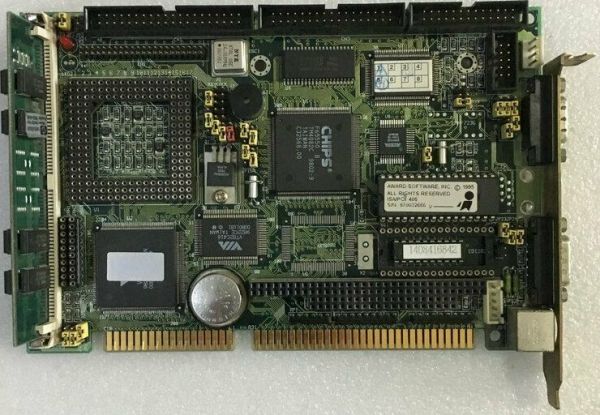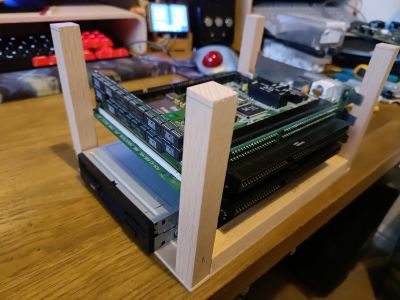This is an old revision of the document!
Advantech PCA-6145 - 486 Single Board Computer
This is a 486 level system (socket 3) on a single 16bit ISA card. It is very compact, with almost everything you would want in a DOS system.
I bought this card in February 2024 with the intention to build an ultra small form factor DOS PC, so that I could put all of the full-size systems away in storage, to claw back some space in my office.
Specifications
- Socket 3 (CPU support from Intel 486DX-33 up to 133MHz models from AMD and the Cyrix/IBM 5×86), supports both 3.3v and 5v chips
- VIA VT82C496G chipset
- 128KB secondary cache
- 1MB C&T 65550 VGA, connected via VESA Local Bus.
- Primary IDE controller (up to 2 devices)
- Floppy controller (up to 2 devices, both 3.5“ - 720,1440,2880k - and 5.25” - 360,1200k - support)
- 1x 72pin SIMM socket, supporting EDO
- Parallel port
- Serial port
- PC/104 interface
- (optional) 10BaseT Ethernet interface
- (optional) Disk On Module storage
Power is by the ISA interface, or by a 3.5“ floppy style connector at the top of the board.
Files
- PCA-6145B/L User manual (.pdf)
- PCA-6145B/L Startup manual (.pdf)
- PCA-6145 Utility disk (zipped .exe)
- PCA-6145B/L - documentation on TheRetroWeb motherboard resource pages
Connections
These are all from the manual, but for quick reference:
NOTE! The locations/labelling for JP15 and JP20 are REVERSED on the user guide and the above images extracted from it The Startup guide has them labelled correctly, but the main user guide is incorrect. Please refer to the Startup guide when setting jumpers for your specific processor!
The startup guide labels the jumpers (correctly) as below:
—
| Position | Function | Position | Function |
|---|---|---|---|
| JP1 | Turbo LED | CN1 | IDE Controller |
| JP2 | Turbo Switch | CN2 | LCD Connector |
| JP3 | HDD LED | CN3 | Floppy Drive Connector |
| JP4 | CPU Frequency Select | COM1 | Serial Port |
| JP5 | CPU Frequency Select | COM2 | Serial Port |
| JP6 | CPU Frequency Select | J1 | Alternative Power Connector |
| JP7 | CPU Type Select | J2 | VGA Connector |
| JP8 | CPU Type Select | J3 | Ethernet Connector |
| JP9 | Battery | J4 | External Keyboard |
| JP11 | CPU Type Select | J5 | External PS/2 Keyboard |
| JP13 | CPU Type Select | J6 | Keyboard Lock |
| JP14 | CPU Voltage Select | J7 | PC Speaker |
| JP15 | PS/2 Mouse Enable | CN4 | Parallel Port |
| JP20,JP21 | CPU Type Select | ||
| JP22,JP23,JP24 | Disk-on-chip Function Set | ||
| JP28 | LCD Control | ||
| JP29 | Watchdog Timer | ||
| JP30 | Reset Switch | ||
| JP35-JP39 | COM2 Select |
Power Connector J1
The pinout for the J1 power connector is silk screened on the board, but can be a little difficult to make out. It is, as follows:
| Pin | Signal |
|---|---|
| 1 | +5v DC |
| 2 | Ground |
| 3 | Ground |
| 4 | +12v DC |
i.e. it is exactly the same as a standard PC 3.5” floppy power connector (4 pin mini spox). The SBC does not appear to have a -12v or -5v DC input header; it will be present on the ISA edge connection, but I am unsure at this time whether either of those voltages is strictly necessary for the SBC to function adequately - it would appear from the manual that it is fine without them.
Arrival / Testing
The card was pretty dirty and very smelly when it arrived, but was otherwise complete and in good condition.
Thoroughly cleaned with 99% IPA, and the rear IO panel rubbed down with fine sandpaper:
Booting
Building the System
Mockup Images
With cards fitted to the riser/backplane, it looks like I will just have enough room for a full sized 3.5“ floppy drive at the bottom, so I can add that in without really increasing the overall size of the system:
Overall dimensions look like it is going to be approximately 20cm front to back, 10cm high and 15-16cm wide.
Case Dimensions
- Top/bottom: 2x 240x150x3mm
- Sides: 2x 240x110x4mm
- Front/back: 2x 158x110x4mm
Case Construction Images
Building the framework, cutting panels to size and test fitting components:
Mounting ISA riser/backplane card:
Using router to radius case edges:
Applied boiled linseed oil to colour/protect natural wood finish:
Case finished, with power, turbo and reset switches, power turbo and HDD status LED's, CF card and 3.5” FDD installed:
Connected up with keyboard and 17“ Dell LCD:
Software Setup
DOS & Drivers
This is a fairly standard setup, there isn't a need for any particular wacky drivers or fancy memory setups. A basic configuration to allow boot in HIMEM + EMM386 (XMS + EMS) and a secondary one to boot with only HIMEM (XMS only) is sufficient for all of the games installed so far.
I am using Win 98SE DOS, which is available on the boot floppy distributed with that version of Windows - mainly because that version of DOS supports FAT32 and large drives. The command line tools to make up a complete DOS install are on the Win 98SE CD. Windows itself is not installed.
Config.sys
[MENU] MENUITEM STANDARD, HIMEM and EMM386 MENUITEM NOEMS, HIMEM Only MENUDEFAULT STANDARD,3 [STANDARD] dos=high,umb device=c:\dos\himem.sys device=c:\dos\EMM386.EXE ram INCLUDE BASIC [NOEMS] device=c:\dos\himem.sys INCLUDE BASIC [BASIC] fileshigh=40 buffershigh=20 rem dosdata=high stacks=9,256 lastdrive=i SHELL=C:\TOOLS\4DOS\4DOS.COM C:\TOOLS\4DOS\ /P
Autoexec.bat
Game Testing
Video BIOS Bugs
The C&T 65550 VESA Local Bus VGA that is embedded in the 486 single board computer is a later video card with a VESA 2.0 BIOS and unfortunately has had the 8×14 VGA font removed. This is apparent in DOS titles that use the 8×14 font to display text:
- SimCity - Main game text and menus
- Shadow of the Comet - Installation/configuration utility only
This manifests as corrupt text display:
Fortunately it is possible to use a small utility to load back the 8×14 font as needed:
- fix8x14b.zip (local copy)
When loaded (it will loadhigh if you have upper memory blocks available via EMM386 or similar), it resolves the problem for the above titles:





































